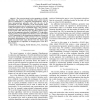Free Online Productivity Tools
i2Speak
i2Symbol
i2OCR
iTex2Img
iWeb2Print
iWeb2Shot
i2Type
iPdf2Split
iPdf2Merge
i2Bopomofo
i2Arabic
i2Style
i2Image
i2PDF
iLatex2Rtf
Sci2ools
ICRA
2005
IEEE
2005
IEEE
SLAM using Incremental Probabilistic PCA and Dimensionality Reduction
— The recent progress in robot mapping (or SLAM) algorithms has focused on estimating either point features (such as landmarks) or grid-based representations. Both of these representations generally scale with the size of the environment, not the complexity of the environment. Many thousand parameters may be required even when the structure of the environment can be represented using a few geometric primitives with many fewer parameters. We describe a novel SLAM model called IPSLAM. Our algorithm clusters sensor data into line segments using the Probabilistic PCA algorithm, which provides a data likelihood model that can be used within a SLAM algorithm for the simultaneous estimation of map and robot pose parameters. Unlike previous work in extracting line-based representations from point-based maps, IPSLAM builds non-point-based maps directly from the sensor data. We demonstrate our algorithm on mapping part of the MIT Stata Centre. Appeared in the Proceedings of the IEEE/RSJ Intern...
| Added | 25 Jun 2010 |
| Updated | 25 Jun 2010 |
| Type | Conference |
| Year | 2005 |
| Where | ICRA |
| Authors | Emma Brunskill, Nicholas Roy |
Comments (0)

